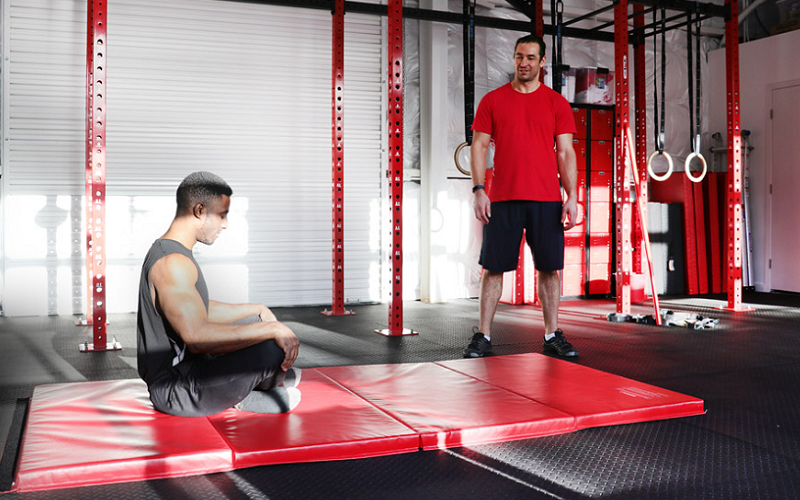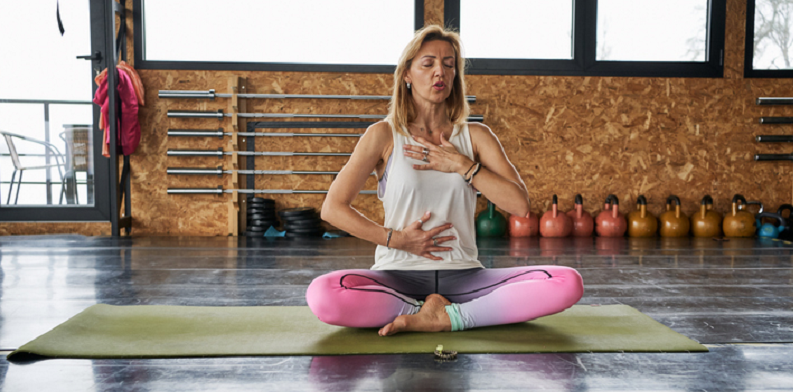
Breathwork is an often overlooked, yet fundamental element of your workout routine. You may meticulously count your reps, carefully measure your running distances, and stay committed to your protein shakes, but are you paying attention to your breath? The way you breathe can profoundly impact your exercise performance, recovery, and overall wellness.
Breathwork is not just about taking air in and out of your lungs; it’s a practice that can shape your body’s response to exercise, influence your focus, and even enhance your endurance. Unfortunately, it remains an unsung hero in most fitness regimens.
Contents
Introduction to Breathwork and Wellness
In the world of fitness and well-being, we often focus on the visible aspects – our strength, endurance, and physical appearance. We count our reps, track our miles, and monitor our nutrition. But have you ever considered the significance of something as simple and involuntary as your breath?
Brief Definition of Breathwork
Breathwork refers to various techniques that involve consciously controlling and manipulating your breathing patterns. Often used in meditation and yoga, these practices are founded on the belief that breath is a bridge between your body and mind. The patterns of our breath can influence our emotional state, stress levels, and overall mental health.
Importance of Breathwork in Overall Wellness
Breathwork isn’t just about maintaining our life force; it’s a powerful tool that can support our overall wellness. It’s been associated with calming the mind, improving sleep quality, enhancing focus, and even supporting pain management. In the context of exercise, breathwork can significantly enhance workout efficiency, improve recovery, and help with stress management [1].

The Science of Breathwork
Before jumping into how breathwork can revolutionize your workouts, it’s essential to understand the science behind it. After all, knowledge is power, especially when it comes to your body. Grasping the basics of breathing physiology and its impact on your nervous system will provide a solid foundation for incorporating breathwork into your fitness routine.
The Physiology of Breathing
Breathing is a natural process that we do without conscious thought. The act of breathing involves inhaling oxygen-rich air into the lungs and exhaling carbon dioxide. This process is critical for the survival of our cells and, ultimately, us. The oxygen we breathe in is transported through the bloodstream and is used by our cells for energy production. At the same time, carbon dioxide, a waste product from this energy production process, is expelled from the body [2].
Breathing is controlled by the respiratory center in the brain, which automatically adjusts the rate of breaths depending on our body’s needs. However, we can also manipulate our breathing consciously, which is the foundation of breathwork.
Impact of Breathwork on the Nervous System
Our breathing patterns have a significant impact on our nervous system, particularly on the balance between the sympathetic and parasympathetic systems. The sympathetic system, often called the ‘fight or flight’ system, prepares the body for action, while the parasympathetic system, or ‘rest and digest’ system, is responsible for relaxation and recovery.
Fast and shallow breathing can activate the sympathetic system, increasing heart rate, blood pressure, and stress hormone levels. On the other hand, slow and deep breathing stimulates the parasympathetic system, promoting relaxation, reducing heart rate, and lowering stress levels. Understanding this can help us utilize breathwork effectively during workouts to optimize our performance and recovery [3].
Relationship Between Breathwork and Exercise
When we exercise, our muscles work harder, leading to an increased demand for oxygen and an increased production of carbon dioxide. This is why our breathing rate and depth naturally increase during physical activity.
But there’s more to breathwork than just letting nature take its course. Conscious control and manipulation of our breathing during exercise can offer significant benefits. For instance, certain breathwork techniques can help maintain a balance between the sympathetic and parasympathetic systems during exercise, enhancing performance and promoting efficient recovery.

The Forgotten Element: Breathwork in Exercise
It’s not uncommon for breathwork to take a backseat in workout discussions. We are often so focused on the ‘active’ parts of our workout like strength, flexibility, and endurance that we forget about the less conspicuous yet crucial element: breathwork.
Overlooking Breathwork in Common Workout Routines
In traditional workouts, focus tends to land primarily on the physical aspects such as perfecting form, increasing weight, repetitions, or duration. Unfortunately, the importance of breathwork often gets lost in the shuffle. This can be due to lack of knowledge or awareness about the benefits of breathwork or simply due to the misconception that breathing will take care of itself.
Furthermore, in the fast-paced modern world, we are often drawn towards visible and immediate results, which breathwork may not directly provide. Hence, it becomes a forgotten element in our workout routines.
Consequences of Poor Breathing Techniques
Ignoring breathwork can lead to a range of negative consequences. These can include less efficient workouts due to poor oxygen supply, slower recovery times, and increased fatigue. Additionally, improper breathing can also lead to an imbalance in the body’s physiological response, causing unnecessary stress and strain.
In contrast, good breathwork practice can enhance athletic performance, increase stamina, improve focus, and reduce stress levels. It’s not just an add-on, but a fundamental part of a balanced, effective workout routine [4].
Studies Linking Breathwork and Performance Enhancement
Scientific research supports the role of breathwork in exercise. Studies have shown that controlled, rhythmic breathing can enhance athletic performance and endurance. For instance, a 2018 study published in the Journal of Physical Therapy Science found that diaphragmatic breathing (a type of breathwork) could improve exercise tolerance in healthy individuals. Another study in the Journal of Sports Sciences reported that rhythmic breathing might enhance swimming performance by optimizing the body’s use of oxygen.

Types of Breathwork for Exercise
Just as there’s a plethora of workouts to cater to different fitness goals, there’s a diverse range of breathwork techniques to complement them. Each type serves a unique purpose and can enhance different aspects of your exercise regimen.
Deep Breathing Techniques
Deep breathing, also known as diaphragmatic breathing, involves drawing breath deeply into your lungs, engaging your diaphragm more than usual. This technique can increase your oxygen intake, enhance your body’s ability to use that oxygen, and promote relaxation.
Deep breathing is particularly beneficial during low-intensity exercises, such as yoga, Pilates, or as part of your cool-down routine. It helps to bring your body into a calm state, aiding in recovery and reducing muscle tension.
Box Breathing
Box breathing, also known as four-square breathing, involves inhaling, holding your breath, exhaling, and holding your breath again, each for the same count (usually four seconds). This technique can calm the mind, reduce stress, and help improve focus and concentration.
Box breathing is a versatile technique that can be incorporated into your warm-up to set your focus for the workout, or during rest intervals between sets to help maintain a calm and focused state [5].
Rhythmic Breathing
Rhythmic breathing involves establishing a set rhythm between your breaths and your movements. For instance, in running, you might inhale for three strides and exhale for two strides. This technique can optimize your body’s oxygen use, increase your stamina, and reduce the risk of injury.
Rhythmic breathing is beneficial in endurance exercises like running, cycling, or rowing, where maintaining a steady, sustainable pace is crucial.
Breath Holding Techniques
Breath holding involves intentionally holding your breath for certain periods. These techniques can help train your body to better tolerate carbon dioxide, enhance your lung capacity, and improve your body’s oxygen efficiency.
Breath holding techniques are useful in sports that require short, intense bursts of effort, such as weightlifting or sprinting, or in underwater sports like swimming or diving.
Performance Breathing Techniques for High Intensity Workouts
Performance breathing techniques are designed specifically to support high-intensity workouts. These can include tactical breathing (inhaling and exhaling in a specific pattern to maintain control and focus), or recovery breathing (deep, controlled breaths to aid in rapid recovery post-exercise).
These techniques are beneficial in high-intensity interval training (HIIT) workouts, martial arts, or any exercise involving high stress and intensity levels [6].
Practical Steps to Incorporate Breathwork Into Your Workout Routine
Now that we’ve explored the various types of breathwork techniques suited for exercise, it’s time to integrate them into your workout routine. While it might seem daunting initially, remember that mastering breathwork, like any other skill, is a process.
Assessing Your Current Breathing Habits
The first step towards incorporating breathwork into your routine is understanding your current breathing habits during exercise. Notice your breath patterns during different types of workouts – is your breath shallow or deep? Fast or slow? Do you hold your breath during certain exercises? This self-awareness will act as your starting point.
Choosing the Right Breathwork Technique
Next, based on your fitness routine and goals, choose a breathwork technique that suits you best. If you’re into high-intensity workouts, performance breathing techniques might be best suited. If you’re into endurance sports, rhythmic breathing could be your go-to. Remember, you can use different techniques for different workouts or even different parts of the same workout.
Practicing the Chosen Breathwork Technique
Start by practicing your chosen breathwork technique outside of your workouts. This can be during a quiet time at home or during your commute. The goal here is to get comfortable with the technique itself before integrating it into your workout.
Incorporating the Technique into Your Regular Workout
Once you’re comfortable with the technique, start incorporating it into your workout routine. Begin with your warm-up and gradually extend it to the rest of your workout. Be patient with yourself during this process. It might feel awkward initially, but with consistent practice, it will become more natural.
Monitoring Progress and Adjusting as Necessary
Finally, keep track of your progress. Notice any changes in your workout efficiency, recovery, and overall well-being. Don’t hesitate to adjust or try different techniques based on your observations. The goal is to find what works best for you.
The Potential Benefits of Mastering Breathwork
By now, you’re well on your way to understanding the crucial role breathwork plays in physical fitness. But let’s delve deeper into the potential benefits that mastering breathwork can bring to your workout and overall well-being. By realizing the profound impact proper breathwork can have, you’ll be more motivated to incorporate it into your daily routine.
Enhanced Athletic Performance
One of the most notable benefits of integrating breathwork into your exercise routine is the potential for enhanced athletic performance. By consciously controlling your breath, you can optimize your body’s use of oxygen, which is critical for energy production during workouts. Additionally, synchronizing your breath with your movements can help establish a rhythm, increasing your efficiency in exercises such as running or swimming.
Improved Recovery Post-Workout
Breathwork can also significantly aid in recovery post-workout. Controlled, deep breathing techniques can stimulate the parasympathetic nervous system, promoting relaxation and aiding in the recovery process. This can help reduce post-workout fatigue and muscle soreness, allowing you to bounce back faster after intense workouts.
Stress Management and Mental Clarity
The benefits of breathwork aren’t just physical; there are significant mental and emotional benefits as well. Regular practice of breathwork can help manage stress levels and promote mental clarity. This can not only improve your focus during workouts but also support your overall mental health and well-being.
Enhanced Lung Capacity
Regular practice of certain breathwork techniques, like deep breathing and breath-holding, can help improve your lung capacity over time. A larger lung capacity allows for more oxygen to be inhaled and utilized during workouts, supporting better endurance and performance.
Greater Mind-Body Connection
Lastly, integrating breathwork into your exercise routine can foster a greater mind-body connection. By focusing on your breath, you become more attuned to your body, enhancing your awareness during workouts. This heightened awareness can improve your form, reduce the risk of injuries, and make your workouts more effective.
References
[1] Breathwork to Help Efficiency while Exercising
[3] Breathing Exercises
[2] Why Breathwork Matters in Your Workout
[4] Breathing Exercises
[5] The 5-minute breathing routine you should try before your next run
[6] Breathing Exercises





